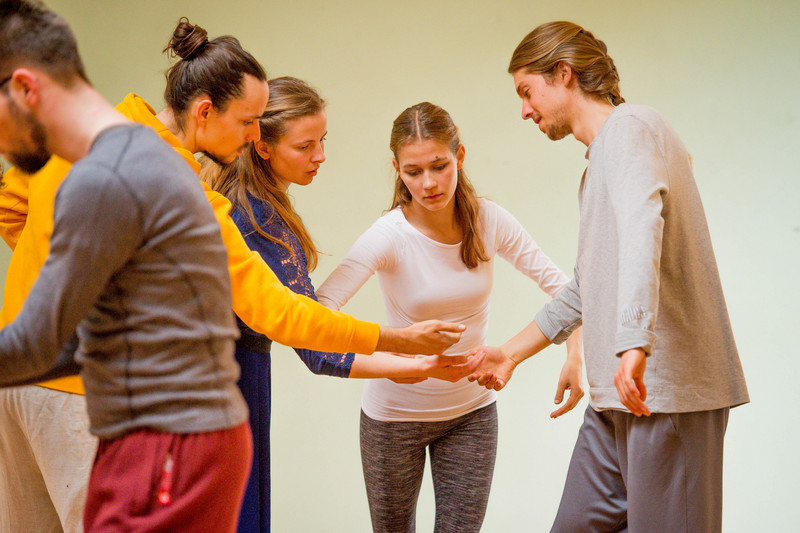"Something was triggered": Studying eurythmy pedagogyepädagogik studieren

Where did you hear about eurythmy?
Laurens Hoschützky: Before I came to Alanus University in 2015, I had never heard of anthroposophy, let alone eurythmy. I was only vaguely familiar with Waldorf schools. Originally, I intended to study ‘philosophy, art and social entrepreneurship’ at Alanus. In the first semester of my study programme, I took part in an event on eurythmy. It was a seminar where eurythmists from a variety of countries met in Alfter to exchange views that was open to eurythmy students as well as other students. I was looking forward to the three-day event, which included both theoretical and practical units. At the end of the weekend, I wasn’t sure what exactly I had done over the past few days, but I realised that something inside me had been triggered. Nevertheless, I set eurythmy aside and focused on my study programme until I came into contact with it again almost three years later.
What motivated you then to study eurythmy pedagogy?
Laurens Hoschützky: My original study programme required me to carry out several practical projects. One of them was supposed to be an art project, and I decided to choose eurythmy as my medium. I asked the eurythmy department if I could join the first year of the programme that had just begun until the end of the first semester. Then I attended the normal classes as part of the course. After the first week, my initial doubts as to whether I really wanted to work with eurythmy had vanished. It became clear to me that I wanted to continue with the study programme. I realised that eurythmy resonated with something in me, and I had the feeling that I had found potential for my personal development. I was inspired by the concept of Waldorf schools and the use of eurythmy to support children from an early age in their physical and mental development. I want to play my part in that. Even if, later on, I do not work with children and adolescents, but with adults, I am convinced that eurythmy can have a positive effect on the social constitution and health of the practitioner, regardless of their age.
What do you think of the study programme? Which elements do you find particularly helpful or useful?
Laurens Hoschützky: For me, music and speech formation are among the most meaningful subjects in addition to sound and tone eurythmy. Both help to delve deeper into the worlds of language and music. In music class, we look at the theoretical side of music – studying music theory basics, music history and the precise analysis of works from different periods – as well as the practical side in the form of musical ear training. Both made it easier for me to approach new pieces of music in tone eurythmy. The same is true of sound eurythmy and speech formation lessons. By dealing with a wide variety of text forms and learning to use our voice as an instrument, we develop an increasingly more precise linguistic intuition – not only for what is said but above all for how something is said. What I learn in both subjects helps me to listen to what music and language have in store for me. That is why they support me in my eurythmic work, which I do not want to do without.
Studying eurythmy pedagogy
Alfter
Even if the number of students at Alanus University is increasing, eurythmy is fringe subject – there are currently 15 students in the first year of the bachelor’s degree programme. The basis for eurythmy pedagogy is the four-year eurythmy foundation study programme that leads to a bachelor’s degree. Prospective teachers can complete a master’s degree at Alanus University or the Freie Hochschule Stuttgart, or a bachelor’s degree in Leiden (Netherlands). In Stuttgart, there is also a full-time offer; in Alfter and Leiden, the courses are organised as a part-time study programme.
So far, the students at Alanus have declined the offer of an MA in ‘Eurythmy in School and Society’. Since the 2020/21 winter semester, the university – in cooperation with the Department of Education – now also offers an MA Education in ‘Pedagogical Practice Research’ with a focus on ‘Eurythmy Pedagogy’ or ‘Eurythmy Therapy’.
Munich
Extra-occupational training for aspiring eurythmy educators is also possible at the Südbayerischen Seminar für Waldorfpädagogik und Erwachsenenbildung (South Bavarian Seminar for Waldorf Pedagogy and Adult Education) in Munich. The five-year programme leads to a diploma and entitles its graduates to a one-year master’s degree programme. In addition to SAGST, the Bund der Freie Waldorfschulen (Association of Waldorf Schools) also sponsors this offer.
Tbilisi and Prague
The worldwide Waldorf School movement is growing dynamically, also and especially in Eastern Europe, where great commitment has been made to founding new schools in many places following the fall of the Iron Curtain. As in Germany, however, there is not enough educational staff – not to mention trained eurythmy teachers – in many locations. Qualified on-site training and continuing education have several advantages over visiting the training centres in Germany or Switzerland: not only does this option eliminate expensive stays abroad and any possible language barriers, but it also makes it easier to integrate the cultural characteristics of the respective country. One challenge encountered in the study of eurythmy, for example, is to match the gestures to the typical sounds of each national language.
For instance, Tbilisi’s Waldorf School in the capital of Georgia runs a teachers’ seminar where basic training for much-needed eurythmy teachers has been offered since 2018. The part-time work-study programme takes five years. The Czech capital of Prague has also offered the opportunity to study eurythmy since autumn 2020. The full-time study programme takes four and a half years and leads to a diploma.
